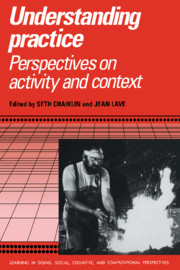Book contents
- Frontmatter
- Contents
- Series foreword
- List of contributors
- Part I Introduction
- Part II Learning craftwork
- 2 Learning to navigate
- 3 Developmental studies of work as a testbench of activity theory: The case of primary care medical practice
- 4 Re-searching psychotherapeutic practice
- 5 Thinking and acting with iron
- 6 Artificial intelligence as craftwork
- 7 Behavior setting analysis of situated learning: The case of newcomers
- Part III Learning as social production
- Part IV Conclusion
- Author index
- Subject index
- Learning in Doing: Social, Cognitive, and Computational Perspectives
6 - Artificial intelligence as craftwork
Published online by Cambridge University Press: 06 January 2010
- Frontmatter
- Contents
- Series foreword
- List of contributors
- Part I Introduction
- Part II Learning craftwork
- 2 Learning to navigate
- 3 Developmental studies of work as a testbench of activity theory: The case of primary care medical practice
- 4 Re-searching psychotherapeutic practice
- 5 Thinking and acting with iron
- 6 Artificial intelligence as craftwork
- 7 Behavior setting analysis of situated learning: The case of newcomers
- Part III Learning as social production
- Part IV Conclusion
- Author index
- Subject index
- Learning in Doing: Social, Cognitive, and Computational Perspectives
Summary
There are two ways in which the visualization processes we are all interested in may be ignored; one is to grant to the scientific mind what should be granted to the hands, to the eyes and to the signs; the other is to focus exclusively on the signs qua signs, without considering the mobilization of which they are but the fine edge.
(Latour, 1986, p. 26)The goal of research in artificial intelligence (AI) is to design runnable computer programs that replicate some aspect of human behavior. A common first step in the design process is to represent in some form the behavior to be replicated. In this chapter we consider representational practice in AI as the practical activity of two researchers working together at a whiteboard (i.e., a white “blackboard” used with colored markers). In locating the science there, we aim to bring into focus its character as socially organized craftsmanship – the crafting together of a complex machinery made of heterogeneous materials, mobilized in the service of developing a theory of mind. In this effort we align ourselves with recent developments in the investigation and respecification of science as practice, beginning with GarfinkePs recommendations (1967) that we take sociology's subject matter to be the identifying details of particular forms of practical action, and Lave's analyses (1988) of the social and material structuring of specifically situated activity systems. Prior ethnomethodological studies of science orient us as well to the centrality of representational devices in the structuring of science practice (see, e.g., Garfinkel, Lynch, & Livingston, 1981; Lynch, 1985; Lynch, Livingston, & Garfinkel, 1983; Livingston, 1986; Lynch & Woolgar, 1990), as does Latour's notion of inscription devices (1986).
Information
- Type
- Chapter
- Information
- Understanding PracticePerspectives on Activity and Context, pp. 144 - 178Publisher: Cambridge University PressPrint publication year: 1993
Accessibility standard: Unknown
Why this information is here
This section outlines the accessibility features of this content - including support for screen readers, full keyboard navigation and high-contrast display options. This may not be relevant for you.Accessibility Information
- 66
- Cited by
